Abstract
Leishmania parasites cause a spectrum of diseases that afflict the populations of 86 countries in the world. The parasites can survive within the lysosomal compartments of the host's macrophages, unless those macrophages are appropriately activated. Despite the fact that protective immunity can be induced by vaccination with crude parasite preparations, little progress has been made toward a defined vaccine for humans. In this study the gene encoding the Leishmania surface proteinase gp63 was cloned and expressed as a cytoplasmic protein in a bacille Calmette-Guérin (BCG) vaccine strain. BALB/c and CBA/J mice were inoculated with a single dose of recombinant BCG and challenged with infective Leishmania major or Leishmania mexicana promastigotes. Significant protection was observed in both mouse strains against L. mexicana and in CBA/J against L. major, whereas only a delay in L. major growth was seen in BALB/c mice. Recombinant BCG also engendered a strong protective response against challenge with amastigotes of L. mexicana, demonstrating that the induced immune response recognized the intracellular form of the parasite. The results support the view that recombinant BCG expressing gp63 may prove a useful vaccine for inducing protective cell-mediated immune responses to Leishmania species causing American cutaneous leishmaniasis.
Full text
PDF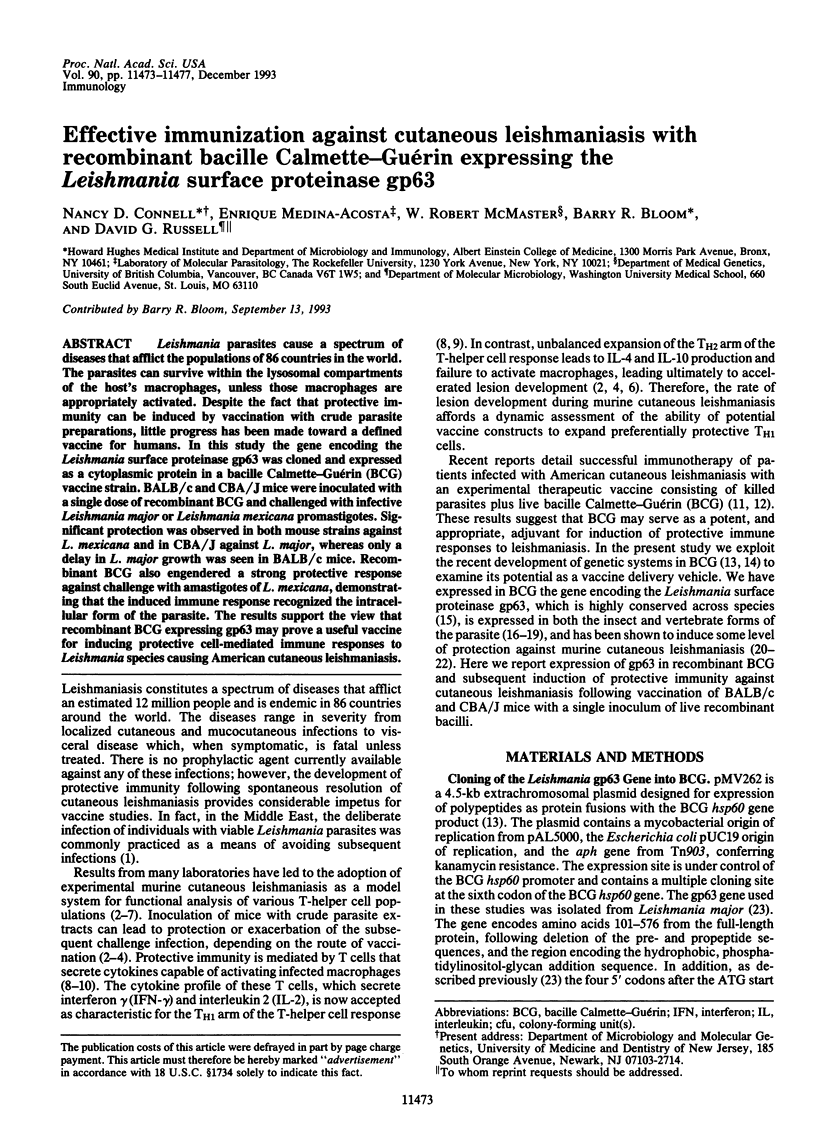
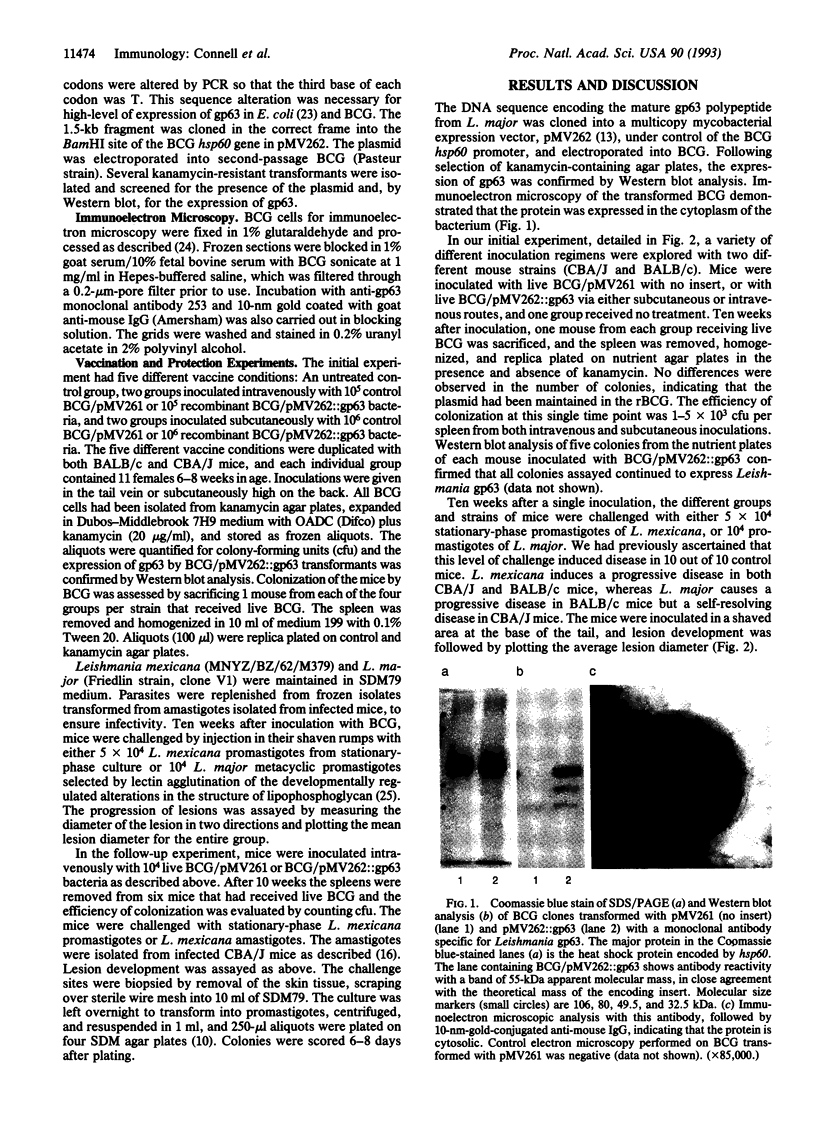
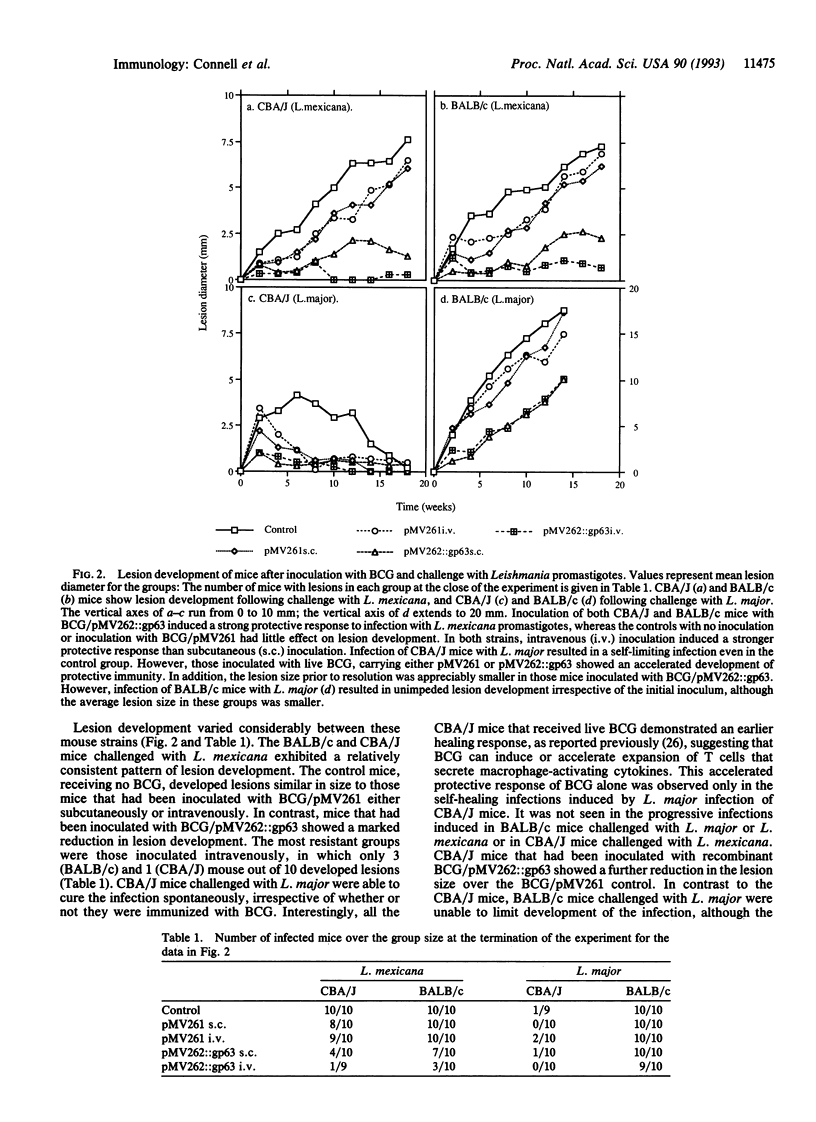
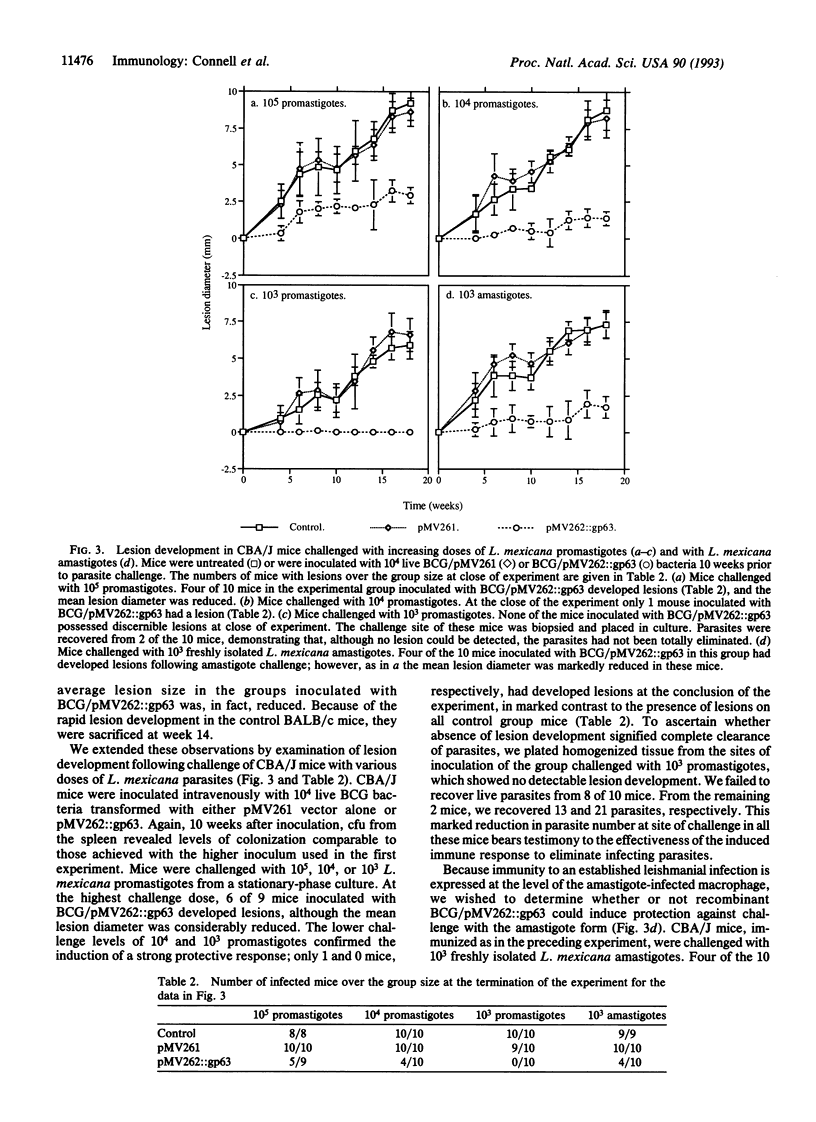
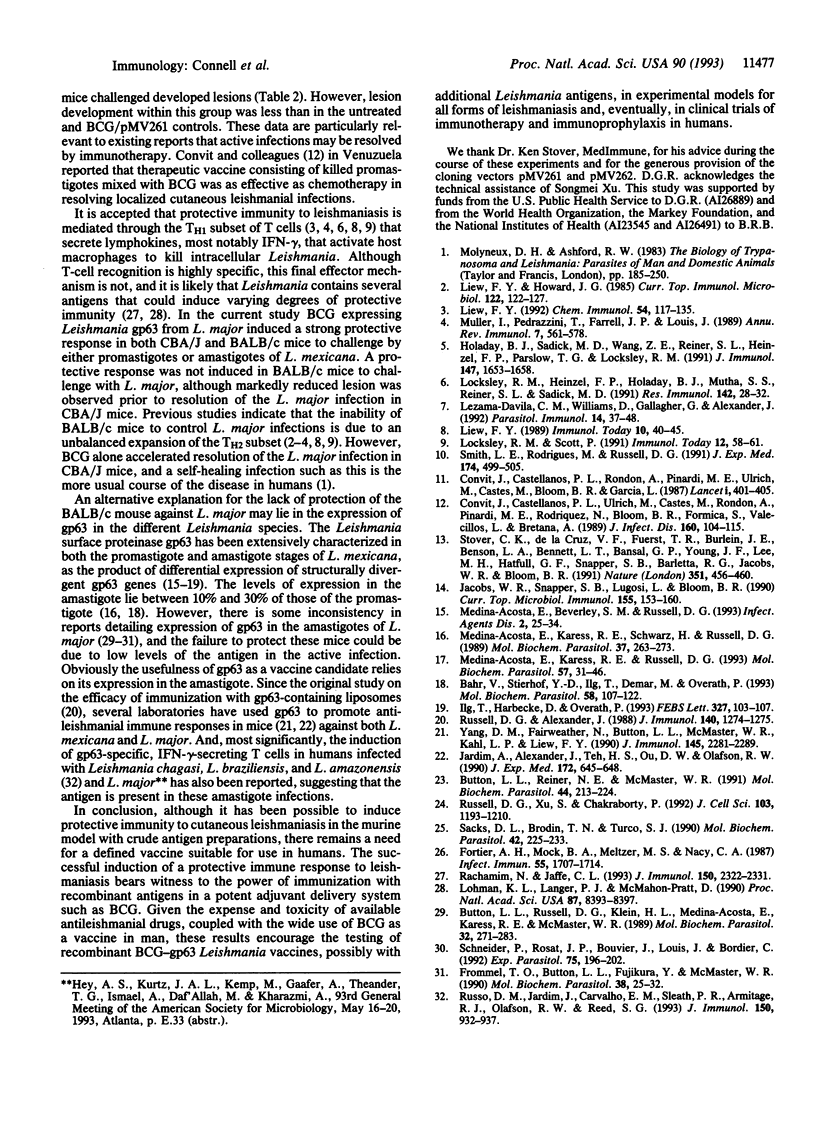
Images in this article
Selected References
These references are in PubMed. This may not be the complete list of references from this article.
- Bahr V., Stierhof Y. D., Ilg T., Demar M., Quinten M., Overath P. Expression of lipophosphoglycan, high-molecular weight phosphoglycan and glycoprotein 63 in promastigotes and amastigotes of Leishmania mexicana. Mol Biochem Parasitol. 1993 Mar;58(1):107–121. doi: 10.1016/0166-6851(93)90095-f. [DOI] [PubMed] [Google Scholar]
- Button L. L., Reiner N. E., McMaster W. R. Modification of GP63 genes from diverse species of Leishmania for expression of recombinant protein at high levels in Escherichia coli. Mol Biochem Parasitol. 1991 Feb;44(2):213–224. doi: 10.1016/0166-6851(91)90007-s. [DOI] [PubMed] [Google Scholar]
- Button L. L., Russell D. G., Klein H. L., Medina-Acosta E., Karess R. E., McMaster W. R. Genes encoding the major surface glycoprotein in Leishmania are tandemly linked at a single chromosomal locus and are constitutively transcribed. Mol Biochem Parasitol. 1989 Jan 15;32(2-3):271–283. doi: 10.1016/0166-6851(89)90076-5. [DOI] [PubMed] [Google Scholar]
- Convit J., Castellanos P. L., Rondon A., Pinardi M. E., Ulrich M., Castes M., Bloom B., Garcia L. Immunotherapy versus chemotherapy in localised cutaneous leishmaniasis. Lancet. 1987 Feb 21;1(8530):401–405. doi: 10.1016/s0140-6736(87)90116-4. [DOI] [PubMed] [Google Scholar]
- Convit J., Castellanos P. L., Ulrich M., Castés M., Rondón A., Pinardi M. E., Rodríquez N., Bloom B. R., Formica S., Valecillos L. Immunotherapy of localized, intermediate, and diffuse forms of American cutaneous leishmaniasis. J Infect Dis. 1989 Jul;160(1):104–115. doi: 10.1093/infdis/160.1.104. [DOI] [PubMed] [Google Scholar]
- Fortier A. H., Mock B. A., Meltzer M. S., Nacy C. A. Mycobacterium bovis BCG-induced protection against cutaneous and systemic Leishmania major infections of mice. Infect Immun. 1987 Jul;55(7):1707–1714. doi: 10.1128/iai.55.7.1707-1714.1987. [DOI] [PMC free article] [PubMed] [Google Scholar]
- Frommel T. O., Button L. L., Fujikura Y., McMaster W. R. The major surface glycoprotein (GP63) is present in both life stages of Leishmania. Mol Biochem Parasitol. 1990 Jan 1;38(1):25–32. doi: 10.1016/0166-6851(90)90201-v. [DOI] [PubMed] [Google Scholar]
- Holaday B. J., Sadick M. D., Wang Z. E., Reiner S. L., Heinzel F. P., Parslow T. G., Locksley R. M. Reconstitution of Leishmania immunity in severe combined immunodeficient mice using Th1- and Th2-like cell lines. J Immunol. 1991 Sep 1;147(5):1653–1658. [PubMed] [Google Scholar]
- Ilg T., Harbecke D., Overath P. The lysosomal gp63-related protein in Leishmania mexicana amastigotes is a soluble metalloproteinase with an acidic pH optimum. FEBS Lett. 1993 Jul 19;327(1):103–107. doi: 10.1016/0014-5793(93)81049-6. [DOI] [PubMed] [Google Scholar]
- Jacobs W. R., Jr, Snapper S. B., Lugosi L., Bloom B. R. Development of BCG as a recombinant vaccine vehicle. Curr Top Microbiol Immunol. 1990;155:153–160. doi: 10.1007/978-3-642-74983-4_11. [DOI] [PubMed] [Google Scholar]
- Jardim A., Alexander J., Teh H. S., Ou D., Olafson R. W. Immunoprotective Leishmania major synthetic T cell epitopes. J Exp Med. 1990 Aug 1;172(2):645–648. doi: 10.1084/jem.172.2.645. [DOI] [PMC free article] [PubMed] [Google Scholar]
- Lezama-Davila C. M., Williams D. M., Gallagher G., Alexander J. Cytokine control of Leishmania infection in the BALB/c mouse: enhancement and inhibition of parasite growth by local administration of IL-2 or IL-4 is species and time dependent. Parasite Immunol. 1992 Jan;14(1):37–48. doi: 10.1111/j.1365-3024.1992.tb00004.x. [DOI] [PubMed] [Google Scholar]
- Liew F. Y. Functional heterogeneity of CD4+ T cells in leishmaniasis. Immunol Today. 1989 Feb;10(2):40–45. doi: 10.1016/0167-5699(89)90302-2. [DOI] [PubMed] [Google Scholar]
- Liew F. Y., Howard J. G. Role of T cells in the unusual cutaneous responses to Leishmania in BALB/c mice. Curr Top Microbiol Immunol. 1985;122:122–127. doi: 10.1007/978-3-642-70740-7_18. [DOI] [PubMed] [Google Scholar]
- Liew F. Y. Induction, regulation and function of T-cell subsets in leishmaniasis. Chem Immunol. 1992;54:117–135. [PubMed] [Google Scholar]
- Locksley R. M., Heinzel F. P., Holaday B. J., Mutha S. S., Reiner S. L., Sadick M. D. Induction of Th1 and Th2 CD4+ subsets during murine Leishmania major infection. Res Immunol. 1991 Jan;142(1):28–32. doi: 10.1016/0923-2494(91)90007-6. [DOI] [PubMed] [Google Scholar]
- Lohman K. L., Langer P. J., McMahon-Pratt D. Molecular cloning and characterization of the immunologically protective surface glycoprotein GP46/M-2 of Leishmania amazonensis. Proc Natl Acad Sci U S A. 1990 Nov;87(21):8393–8397. doi: 10.1073/pnas.87.21.8393. [DOI] [PMC free article] [PubMed] [Google Scholar]
- Medina-Acosta E., Beverley S. M., Russell D. G. Evolution and expression of the Leishmania surface proteinase (gp63) gene locus. Infect Agents Dis. 1993 Feb;2(1):25–34. [PubMed] [Google Scholar]
- Medina-Acosta E., Karess R. E., Russell D. G. Structurally distinct genes for the surface protease of Leishmania mexicana are developmentally regulated. Mol Biochem Parasitol. 1993 Jan;57(1):31–45. doi: 10.1016/0166-6851(93)90241-o. [DOI] [PubMed] [Google Scholar]
- Medina-Acosta E., Karess R. E., Schwartz H., Russell D. G. The promastigote surface protease (gp63) of Leishmania is expressed but differentially processed and localized in the amastigote stage. Mol Biochem Parasitol. 1989 Dec;37(2):263–273. doi: 10.1016/0166-6851(89)90158-8. [DOI] [PubMed] [Google Scholar]
- Müller I., Pedrazzini T., Farrell J. P., Louis J. T-cell responses and immunity to experimental infection with leishmania major. Annu Rev Immunol. 1989;7:561–578. doi: 10.1146/annurev.iy.07.040189.003021. [DOI] [PubMed] [Google Scholar]
- Rachamim N., Jaffe C. L. Pure protein from Leishmania donovani protects mice against both cutaneous and visceral leishmaniasis. J Immunol. 1993 Mar 15;150(6):2322–2331. [PubMed] [Google Scholar]
- Russell D. G., Alexander J. Effective immunization against cutaneous leishmaniasis with defined membrane antigens reconstituted into liposomes. J Immunol. 1988 Feb 15;140(4):1274–1279. [PubMed] [Google Scholar]
- Russell D. G., Xu S., Chakraborty P. Intracellular trafficking and the parasitophorous vacuole of Leishmania mexicana-infected macrophages. J Cell Sci. 1992 Dec;103(Pt 4):1193–1210. doi: 10.1242/jcs.103.4.1193. [DOI] [PubMed] [Google Scholar]
- Russo D. M., Jardim A., Carvalho E. M., Sleath P. R., Armitage R. J., Olafson R. W., Reed S. G. Mapping human T cell epitopes in leishmania gp63. Identification of cross-reactive and species-specific epitopes. J Immunol. 1993 Feb 1;150(3):932–939. [PubMed] [Google Scholar]
- Sacks D. L., Brodin T. N., Turco S. J. Developmental modification of the lipophosphoglycan from Leishmania major promastigotes during metacyclogenesis. Mol Biochem Parasitol. 1990 Sep-Oct;42(2):225–233. doi: 10.1016/0166-6851(90)90165-i. [DOI] [PubMed] [Google Scholar]
- Schneider P., Rosat J. P., Bouvier J., Louis J., Bordier C. Leishmania major: differential regulation of the surface metalloprotease in amastigote and promastigote stages. Exp Parasitol. 1992 Sep;75(2):196–206. doi: 10.1016/0014-4894(92)90179-e. [DOI] [PubMed] [Google Scholar]
- Smith L. E., Rodrigues M., Russell D. G. The interaction between CD8+ cytotoxic T cells and Leishmania-infected macrophages. J Exp Med. 1991 Sep 1;174(3):499–505. doi: 10.1084/jem.174.3.499. [DOI] [PMC free article] [PubMed] [Google Scholar]
- Stover C. K., de la Cruz V. F., Fuerst T. R., Burlein J. E., Benson L. A., Bennett L. T., Bansal G. P., Young J. F., Lee M. H., Hatfull G. F. New use of BCG for recombinant vaccines. Nature. 1991 Jun 6;351(6326):456–460. doi: 10.1038/351456a0. [DOI] [PubMed] [Google Scholar]
- Yang D. M., Fairweather N., Button L. L., McMaster W. R., Kahl L. P., Liew F. Y. Oral Salmonella typhimurium (AroA-) vaccine expressing a major leishmanial surface protein (gp63) preferentially induces T helper 1 cells and protective immunity against leishmaniasis. J Immunol. 1990 Oct 1;145(7):2281–2285. [PubMed] [Google Scholar]



